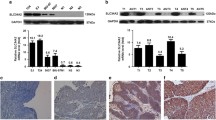Summary
In order to elucidate the mechanisms of multidrug resistance (MDR) in bladder cancer, the expression of glutathione S-transferase-π (GST-π) and multidrug resistance associated protein (MRP) in tissue samples resected from 44 patients and 6 normal bladder mucosa as control was detected by using immunohistochemical method, and the results were analyzed by computer-assisted image analyzing system (IAS) to achieve semi-quantitative data. In addition, correlation between the expression of both factors was studied. The results showed that the positive expression rate of GST-π and MRP in bladder cancer was 72. 7 % (32/44) and 68. 2 % (30/44) respectively, significantly higher than those in normal bladder mucosa, being 16. 7 % and 33. 3 % respectively. The rate of GST-π positive staining was increased correspondingly with tumor grade and stage elevated, being higher in recurrent tumors treated by chemotherapy, but not significantly (P > 0. 05). There was no significant differences between the expression of MRP and tumors’ behaviors and clinical characters. However, the results demonstrated that the correlation between the expression of both resistant factors was very evident (r = 0. 695,P < 0. 0025). It was suggested that the activation of GST-π and MRP might occur during malignant transformation of normal mucosa, but tumors’ differentiation and progression could not be the unique factors that influenced both overexpression. Chemotherapy might be another important reason. The correlation of both indicated that there was a common mechanism regulating their expression probably, which made them play a pivotal role in chemotherapy drug resistance of bladder cancers.
Similar content being viewed by others
References
Edict J A, Ling V. The biochemistry of P-glycoproteinmediated multidrug resistance. Annu Rev Biochem, 1989, 58: 137
Cole S P C, Bhardwaj G, Gerlach J Het al. Overexpression of a transporter gene in a multidrug-resistant human lung cancer cell line. Science (Washington DC), 1992, 258: 1650
Shen H, Kanvar L, Tew K D. Importance of glutathion and associated enzymes in drug response. Oncol Res, 1997, 9: 295
Tew K D. Glutathion-associated enzymes in anticancer drug resistance. Cancer Res, 1994, 54: 4313
Hayes T D, Pulford D J. The glutathione s-transferase supergene family: regulation of GST and the contribution of the isoenzymes to cancer chemoprotection and drug resistance. Crit Rev Biochem Mol Biol, 1995, 30: 445
Masuda H, Ozols R F, Lai G Met al. Increased DNA repair as a mechanism of acquired resistance to cis-diamminedichloroplatinum (I) in human ovarian cancer cell lines. Cancer Res, 1988, 48: 5713
Kotoh S, Naito S, Yokomizo Aet al. Increased expression of DNA topoisomerase I gene and collateral sensitivity to camptothecin in human cisplatin-resistant bladder cancer cells. Cancer Res, 1999,3248
Ishikawa T. The ATP-dependent glutathione s-conjugate export pump. Trends Biochem Sci, 1992, 17: 463
Singh S V, Roberts B, Gudi V Aet al. Immunohistochemical localization, purification and characterization of human urinary bladder glutathione s-transferases. Biochim Biophys Acta, 1991, 1074: 363
Tew K D, Monky A, Barone Let al. Glutathione-associated enzymes in the human cell lines of the national cancer institute screening program. Mol Pharmacol, 1996, 50: 149
Leter I, Teditschky G, Buchholz Cet al. The MRP gene encodes an ATP-dependent export pump for leukotriene C4 and structurally related conjugates. J Biol Chem, 1994, 269: 27807
Zaman G J R Lankelma, van Tellingen Oet al. Role of glutathione in the export of compounds from cells by the multidrug resistance-associated protein. Proc Natl Acad Sci USA, 1995, 92: 7690
Grant C E, Valdimarsson G, Hipfner D Ret al. Overexpression of multidrug resistance-associated protein (MRP) increases resistance of natural product drugs. Cancer Res, 1994, 54: 357
Kim W J, Kakehi Y, Wu W Jet al. Expression of the multidrug resistance-related genes (mdrl, MRP, GST-π and DNA topoisomeraseI) in urothelial cancers. Br J Urol, 1996, 78: 361
Author information
Authors and Affiliations
Additional information
This project was supported by a grant from the fund of science of Hubei Province (No. 99J124).
Rights and permissions
About this article
Cite this article
Weimin, Y., Xiaoyong, Z., Chunlian, C. et al. Correlative expression of glutathion S-Transferase-π and multidrug resistance associated protein in bladder transitional cell carcinoma. Current Medical Science 20, 311–314 (2000). https://doi.org/10.1007/BF02888188
Received:
Published:
Issue Date:
DOI: https://doi.org/10.1007/BF02888188




